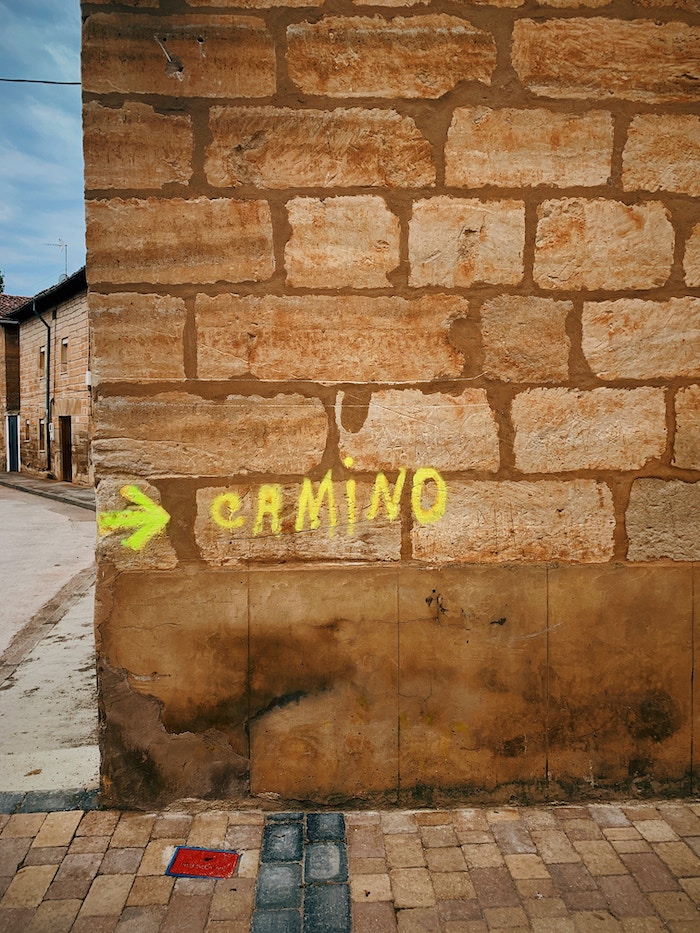
Smudging bundle. Credit: Kayla Maurais, via Unsplash.com
What is Smudging?
The term “Smudging” is very specific. It comes from a traditional practice carried out by some Native American cultures. Sacred herbs or resins would be burned, as part of a spiritual ritual. It’s a herbal medicine, and different tribes and areas would have their own practices and meanings attached to the herb itself, as well as the process.
Holy Smoke
Burning resins/herbs for spiritual or energetic reasons or rituals, has been part of different cultures throughout the world since ancient times right up to the modern day. Some examples of this practice are carried out by native Australian peoples, Scots (in a tradition called “saining”). Both Buddhism and the Catholic church make use of smoke as part of their practices/rituals.
Generally though, the meaning, symbolism and protocol of these rituals as well as the process of the rituals, were safeguarded and performed only by Elders or someone who had the practice handed down to them specifically.
Using smudging bundles for space cleansing would not normally have been something everyone would do. It would often be more gate-kept than that, as it was in the realm of the sacred. Of course burning a candle/taper, or lighting a stick of incense would be more of an everyday devotional/spiritual ritual act, for example in Christianity and Buddhism. There is still symbolism and sacredness, but the ritual itself was much more straightforward in practice.
Energy Working and Energetic Cleansing
These days, with more and more people learning and practicing Reiki as a spiritual (as well as a professional) practice, energetic cleansing is something more and more people are aware of, and are doing for themselves. But it is worth mentioning that there are more ways to cleanse yourself and your space than smudging with sage! If you’re Reiki attuned, then you have one such tool in your hands! Giving Reiki to the corners of a room, windows, doors, floors, any areas you feel drawn to, with the intention that it is for cleansing, will do a grand job of energetic cleansing. And there’s a great deal else you can do to cleanse the energy of a space, including using incense sticks and cones, opening a window regularly, cleaning, using sound (bells or music). I could write a whole article on the subject, in fact!
The Growing Popularity of “Smudging”
But the term “Smudging” is more widespread and generic in its use than its original (true) context. With Spiritual/”New Age” practices ever more popular and mainstream, it’s increasingly easy to source ready-made Smudging bundles or even kits – which are now available at supermarkets, and online, in a variety of designs, stylings and price points. Smudging paraphernalia is now more home decor than spiritual tool!
It’s easy to see why it’s become so popular, with so many people. Smudging as part of Women’s circles or Yoga sessions, offers a heady experience of the sensory and energetic, evocative of mysticism and highly engaging. And because of the appeal Smudging holds, the term is often a placeholder for pretty much all forms of ritual/stylised smoke-based space cleansing practice.
I’m guilty of this, in the title to this article, as well! Being a bit of a geeky person, frankly, I would have preferred to use a term other than “smudging bundle” if I could have found a catchy, yet accurate alternative… But if I’d said “energetic smoking herbal bundle” instead of “smudging bundle,” I’m guessing the title wouldn’t have conjured up the image I was after, dearest Dumplings!
However, it’s not just my pedantry about language that’s been irked by the craze for smudging. For some years now, growing concern has been expressed by Native American communities about the over-harvesting of White Sage. This is in addition to members of Native communities within the U.S. viewing smudging without awareness and respect for its spiritual significance, as cultural appropriation.
The Sage Alternative
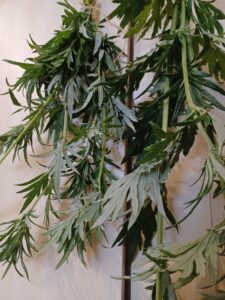
A bunch of Mugwort hanging up to dry (credit E. Melanaphy)
So what’s a lover of ritual, intuitive, creative, spiritual practice and energy work to do? And how can one be more sustainable, connected to your own local ecosystem and get crafty at the same time?
The answer is simple: craft your very own “Black Sage” Bundle!
Black sage is not really sage per se—it’s actually one of my favorite witchy herbs: Mugwort! The benefits of Mugwort include the fact that it is:
a. plentifully available on most continents (so much so, that people often class Mugwort as a weed);
b. prized since ancient times as a sacred herb, from Pagan practice through to Christianity, with associations with the “Crone” or “Hag” archetype. She’s the wise old grandmother who crosses between dimensions, and is the fearsome protector of the divine feminine;
c. a powerhouse of cleansing and shifting stagnated Qi/Ki/Ch’i. Some people use brooms made from mugwort to sweep a room/house’s energy clean. And in Acupuncture and Traditional Chinese Medicine, it’s processed and refined to produce Moxa;
d. great for dream-work, and visions. It contains the psychoactive substance “thujone” like its cousin Wormwood.
All in all, it would be difficult to find a better alternative than the wonderful Mugwort! And I was over the moon (sorry—couldn’t resist a geeky pun there! Mugwort’s latin name is Artemisia Vulgaris and Artemis is the Goddess of the Moon) to discover outcrops of it growing on the verge of the footpath, with my local community walking group!
So I did my research, harvested some Mugwort (respectfully and responsibly taking only a small part of the clump), and set about creating my very own Mugwort Bundles. Here’s how I did it—stage by stage!
How I Made my Bundles
1. Harvest & check

The base of the bundle
I harvested several long branches (which are less leafy but better structurally) and several shorter, more leafy boughs. Before construction, I checked over each of the branches and leaves, to ensure there were no insects/spiders/larvae/other animals living on them or hitching a ride. If there were, I took the leaf they were on outside and popped it into my garden, where they could live their lives peaceably.
2. Sort, divide and neaten
I lined up the cut ends of the Mugwort branches, and divided them in to two fairly even piles, to make two bundles. I placed the taller stems more centrally and the bushier leafier shorter ones I tried to group evenly all the way around.
3. Secure the bundles: wrap and tie off the base
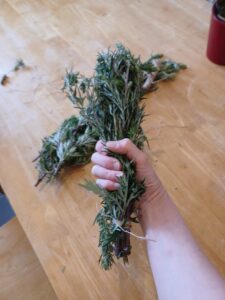 Using a cotton-based twine (with no plastic), I tied and wrapped the twine several times, around the base of the bundle, to hold it all together.
Using a cotton-based twine (with no plastic), I tied and wrapped the twine several times, around the base of the bundle, to hold it all together.
4. Fold over the longer branches
Grasping the tied base firmly with one hand, I took the larger stems near the other end, with my other hand, and bent them down, so that the tips were close to the bound end – bent almost double.
5. Secure and tie in the folded branch ends
I then held these longer branches in place with one hand, and wrapped and tied the tips of the longer branches, to the bundle, close to the bound base. It looks super messy at this stage. That’s OK.
6. Wrap & tie all the way along the bundle’s length
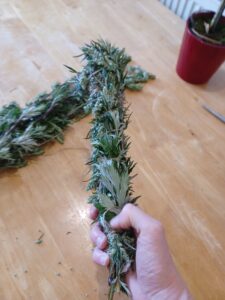
The wrapped bundle – before drying.
Then came the process of tying, wrapping and binding all the branches and leaves in a criss-cross fashion, along the whole length of the bundle. I tied and wove the twine firmly. This is so that the natural shrinkage when the bundle dries out, wouldn’t loosen too much and compromise its integrity. There do need to be gaps for air to circulate, so that it can dry evenly all the way through.
7. Neaten & hang up to dry out
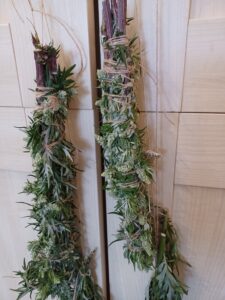
Leave the bundles to dry for at least 1 week
Once completed, I tucked in any extraneous leaves & seed-heads; and hung the bundles upside down from a far kitchen cupboard (in a cool, well-ventilated spot, out of direct sunlight).
I let the bundles dry, turning them daily, to make ensure they dried evenly and thoroughly. After they were done (around 3 weeks later) I took them down and stored them in a cool, dark dry room.
There you have it! Simple when you know how! There’s very little you can get wrong when making these bundles!
Plan B
That said, if your bundles do over-shrink or lose structural integrity, you can recycle the Mugwort! As long as there’s no mould and the leaves are properly dry, you’re good to go!
Cut the twine and strip off the Mugwort leaves, before storing them in an air-tight container. You can then use them as a loose incense over charcoal, or stuff a small cushion or sachet with them, to use as an aid to lucid dreaming!
A final word on safe and responsible foraging!
Please do always make sure you are harvesting the right species. There are other species which appear similar to Mugwort, to which some people can be severely allergic. I used a plant identification app, and double-checked in 2 herbalism reference books at home, before I got started with crafting these bundles.
And I know you very likely know this already, but please don’t harvest where there’s only a little of the herb present. Plants form a crucial part of their ecosystems, helping to keep a stable, healthy balance in that environment. Please harvest only where there’s a plentiful supply. Take at maximum 1/10 of what’s there, and only ever what you can make use of, yourself. Others may also be foraging in that area.
It’s also worth being mindful that it’s better to cut Mugwort’s stem rather than pulling up the whole plant – roots and all. That way the plant may re-grow branches from the roots that same season, and you’re not negatively impacting on the structural integrity of the soil either.
I wish you happy wildcrafting, Dumplings! May you connect deeply with the spirits and energy of the land around you. May you bring that special connection into your home, and also into your spiritual practice, if you feel so inspired!
Get more like this—Sign up for our daily inspirational newsletter for exclusive content!
__
Photo: Unsplash; Ema Melanaphy


